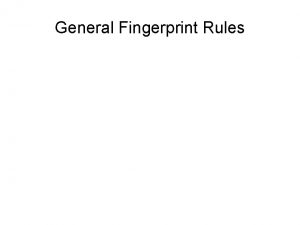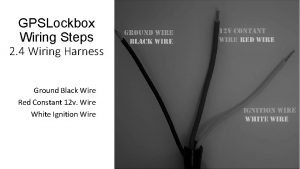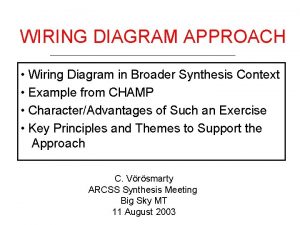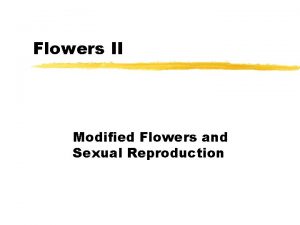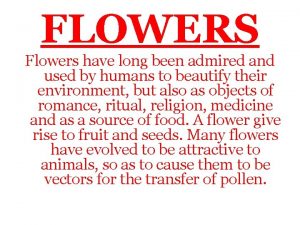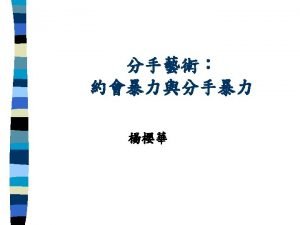Selecting and Wiring Flowers Wiring Techniques essential to












































- Slides: 44

Selecting and Wiring Flowers

Wiring Techniques • essential to the floral designer • only wire a flower if it cannot be used satisfactorily without it

Florists wire • used for a number of reasons • straighten slightly crooked stems • support weakened stems

Florists wire • keep flowers upright and help prevent wilting • hold flowers and foliage in a desired position

Florists wire • prevent flower heads from breaking off the stem • replace flower stems on corsages so the corsage stem is not bulky

Florists wire • add accessories to corsages and arrangements

Selecting wires • commonly sold in twelve pound boxes • containing straight wires 18 inches long • number of wires per box varies according to the size

Selecting wires • wires are coated with green enamel which helps prevent rusting • green color makes them less noticeable in the design

Selecting wires • wire may also be purchased on spools for special needs such as making garlands or wreaths

Sizes of wire • florist wire comes in various weights and diameters called gauges • size ranges from 18 thickest, to 32 - thinnest

Sizes of wire • wire gauge numbers decrease as the wire gets larger • 20 -26 gauge is the most common

Sizes of wire • proper size of wire is important • too large a wire will damage the flower • if wire is too thin the flower will not be properly

Sizes of wire • select the smallest wire that will support the flower and still hold it in place

Wiring • should only be done when necessary • too much wire can detract from an arrangement

Sizes of wire • the size wire you choose is dependent upon the weight of the flower and the intended use

Methods of wiring • straight wire method • used when the stem remains attached to the flower • most often used when wiring flowers for vase arrangements

Straight Wire • hold a piece of 20 gauge wire about one half inch from the end • insert into the calyx - fleshy part of the flower below petals

Straight wire • push wire up toward your finger • wrap the wire carefully around the stem going between the leaves • wire should show as little as

Hook Method • used on daisies, asters, chrysanthemums and other flowers used for corsages and funeral work • method is recommended for any flower that breaks easily at the stem

Hook Method • hook helps prevent flower from breaking off of stem • stem may be removed or left intact • depends on use of flower

Hook Method • for corsage work, stem is cut 1/2 inch below the calyx • all remaining foliage is removed from stem

Hook Method • wire is pushed up through the calyx and out the top of the flower • wire may also be pushed along the center of the stem

Hook Method • bend of wire that sticks out top of flower into a hook • pull the wire and the hook downward so that the hook disappears into the flower head

Hook Method • if using the flower in a corsage, it is now ready to be taped • if using in an arrangement, wire is bent around stem to support it

Piercing method • used on flowers that have an enlarged calyx • such as carnations and roses • stem is removed about one inch below calyx if for corsage

Piercing method • insert a wire through the calyx at a point halfway between the calyx and the petals

Piercing method • if for a vase arrangement, push wire till it sticks two inches beyond the calyx • bend both ends of wire down • wrap longest end around stem

Piercing method • for corsage, push the wire through to the midpoint • bend both sides down and tape

Wrap method • used on foliage made of many small leaflets • leatherleaf • flowers composed of many small florets

Wrap method • cut the stem so that a small portion of the stem remains on the leaf • make a hairpin from 26 -28 gauge wire

Wrap method • hang the hairpin over the lowest pair of leaflets so that the bend in the hairpin rests behind the stem

Wrap method • wind one wire over both the other wire and the stem of the leaflet • wrap the stem and wire with tape

Stitch method • used most commonly on broad, leathery skinned leaves • foliages that have been wired are much easier to use because the wire creates an extended petiole

Stitch method • from the back side of the leaf, take a 26 gauge wire and pass the wire through the leaf under the midrib • stitch is made about halfway up the leaf

Stitch method • bend both ends of the wire down the back of the leaf • wrap one half of the wire around the other half and the petiole several times

Stitch method • tape the stem beginning at the base of the leaf

Wiring • it is important to select the method that best suits the type of flower and its intended use • keep all wire hidden as much as possible

Floral Taping • non sticky tape that will stick to itself when stretched • used primarily in corsage work to cover wires • bind wires to flower stems

Floral Taping • bind wired or taped flowers together • half inch width is the most common • one inch is also made but is not readily available

Floral Taping • primary brand names are “Floratape” and “Parafilm” • various colors available • moss green and foliage green are the most common

Floral Taping • white tape is used in wedding work while brown may be used for dried flowers • taping requires skill that is developed with practice

Floral Taping • taping is achieved by stretching the tape as you wrap it around the stem or wire or twist the wire or stem into the floral tape

Floral Taping • the tape becomes sticky as you stretch it and will stick to itself • properly taped wires will be smooth and lightly taped

Floral Taping • if the tape does not adhere to the wire and is loose, increase the tension on the tape.
 Selecting text means
Selecting text means Wiring
Wiring What are the factors of 16
What are the factors of 16 Methods of wiring flowers
Methods of wiring flowers Plamatic acid
Plamatic acid Indirect cost of expatriate failure
Indirect cost of expatriate failure Rules in core location
Rules in core location Identifying and selecting systems development projects
Identifying and selecting systems development projects Chapter 18 eggs selecting and storing eggs
Chapter 18 eggs selecting and storing eggs Acquiring information systems and applications
Acquiring information systems and applications Potential market
Potential market Recruiting and selecting sales personnel
Recruiting and selecting sales personnel Selecting organizing and interpreting information
Selecting organizing and interpreting information What three brainstorming methods can you follow
What three brainstorming methods can you follow Hiring training and evaluating employees
Hiring training and evaluating employees Chapter 5 selecting a topic and a purpose
Chapter 5 selecting a topic and a purpose Chapter 5 selecting a topic and a purpose
Chapter 5 selecting a topic and a purpose Fonctions techniques et solutions techniques
Fonctions techniques et solutions techniques Selecting an hris
Selecting an hris Selecting investment in global market
Selecting investment in global market Portrait ipn mould guide
Portrait ipn mould guide The logical view of data is
The logical view of data is Chapter 9 driving in urban traffic answers
Chapter 9 driving in urban traffic answers Selecting investment in global market
Selecting investment in global market Brand memorability example
Brand memorability example The circular chart used to remember color relationships
The circular chart used to remember color relationships Chapter 7 selecting the channel members
Chapter 7 selecting the channel members Selecting channel members
Selecting channel members Selecting major appliances
Selecting major appliances Selecting a form of business ownership
Selecting a form of business ownership Selecting the promotional mix
Selecting the promotional mix Guidelines for selecting proper device based controls
Guidelines for selecting proper device based controls Criteria for selecting the right scm tool is based on
Criteria for selecting the right scm tool is based on Pitfalls in selecting new ventures
Pitfalls in selecting new ventures People differentiation
People differentiation A process of receiving selecting organizing
A process of receiving selecting organizing Formulating objectives examples
Formulating objectives examples Electrical wiring materials
Electrical wiring materials Chapter 44 automotive wiring and wire repair
Chapter 44 automotive wiring and wire repair Analog input and output devices
Analog input and output devices Batten wiring
Batten wiring Unit 33 electrical principles and wiring materials
Unit 33 electrical principles and wiring materials Flowers lines
Flowers lines Plants have male and female parts
Plants have male and female parts To his love poem
To his love poem






